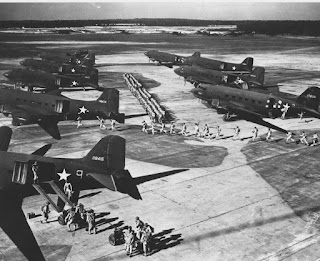Reminiscing on LGB During WWII
On September 2, 1945, World War II officially came to an end. For the United States to emerge victorious as it did, it required involvement from all corners of the nation. Long Beach Airport (LGB), known then as Daugherty Field, was a key contributor as it was home to airfields operated by the U.S. military as well as the Douglas Aircraft manufacturing plant. These accommodations allowed the airport to play a crucial role in the war effort.
Long Beach Airport was geographically strategic during WWII due to its proximity to the coast. Expanded to 500 acres prior to the war, the airfield was given to the military after the attack on Pearl Harbor. The Naval Auxiliary Air Station (NAAS) at the airport was committed to servicing carrier borne aircraft as well as patrol planes. Meanwhile, the Army Air Corps occupied the remaining aviation facilities and established a training base.
Among the pilots stationed in Long Beach was aviation icon Barbara London. The only woman in WWII to be awarded the distinguished Air Medal, London was stationed at the Long Beach Army Airfield and commanded a squadron of 18 woman pilots under the Army’s Air Transport Command Ferrying Division.
The war saw immense manufacturing take place at Long Beach Airport. Meeting President Roosevelt’s earlier call for the U.S. to be the “Arsenal of Democracy,” the Douglas Aircraft facility got to work almost immediately after Pearl Harbor. It would go on to deliver 4300 C-47’s, building one every three hours, in addition to 2200 A-20’s and A-26’s as well as 3000 B-17’s.
This wartime production was not possible without the involvement of women. Rosie the Riveter was a considerable presence at Douglas, where women made up 50 percent of the workforce. They proved women were more than capable of working outside the home, an idea previously implausible in American culture.
Long Beach Airport returned to its commercial functions following the war. However, the wartime operations would leave its impact. Barbara London would go on to become a Major in the U.S. Air Force, continuing to inspire women to pursue aviation. The site adjacent to the former Douglas plant is now Rosie the Riveter Park, named in honor of the women who worked there. As for the airport itself, it remains a manufacturing and development site for various aircraft companies.
Daugherty Field was home to both the Army and Navy during WWII
Long Beach Airport was geographically strategic during WWII due to its proximity to the coast. Expanded to 500 acres prior to the war, the airfield was given to the military after the attack on Pearl Harbor. The Naval Auxiliary Air Station (NAAS) at the airport was committed to servicing carrier borne aircraft as well as patrol planes. Meanwhile, the Army Air Corps occupied the remaining aviation facilities and established a training base.
Among the pilots stationed in Long Beach was aviation icon Barbara London. The only woman in WWII to be awarded the distinguished Air Medal, London was stationed at the Long Beach Army Airfield and commanded a squadron of 18 woman pilots under the Army’s Air Transport Command Ferrying Division.
The war saw immense manufacturing take place at Long Beach Airport. Meeting President Roosevelt’s earlier call for the U.S. to be the “Arsenal of Democracy,” the Douglas Aircraft facility got to work almost immediately after Pearl Harbor. It would go on to deliver 4300 C-47’s, building one every three hours, in addition to 2200 A-20’s and A-26’s as well as 3000 B-17’s.
This wartime production was not possible without the involvement of women. Rosie the Riveter was a considerable presence at Douglas, where women made up 50 percent of the workforce. They proved women were more than capable of working outside the home, an idea previously implausible in American culture.
Barbara London joined the Air Force Reserve following the war
Long Beach Airport returned to its commercial functions following the war. However, the wartime operations would leave its impact. Barbara London would go on to become a Major in the U.S. Air Force, continuing to inspire women to pursue aviation. The site adjacent to the former Douglas plant is now Rosie the Riveter Park, named in honor of the women who worked there. As for the airport itself, it remains a manufacturing and development site for various aircraft companies.




This comment has been removed by a blog administrator.
ReplyDeleteThis comment has been removed by a blog administrator.
ReplyDeleteThese are the quite hurtful topics to discuss.
ReplyDeletemeet and greet Gatwick
meet and greet at Gatwick